A small fishing village, Leeman is the major town on what is known as the Coolimba Coast. It is named after the original fishing settlement in the area to the north of Leeman.

The coastline caters for an array of water activities including fishing, swimming, surfing and windsurfing. The township also supports a fishing fleet, which traverse the bountiful oceans in search of the lucrative western rock lobster during the season from November to June.

Seal and Sea Lions
The area is renowned for its significant seal and sea lion populations - it's not unusual to spot one of these captivating creatures lazing in the sun on the beach. Beagle Island, north of Leeman, a breeding colony and home to the largest population of the Australian Sea Lion in Western Australia, estimated between 150-250 animals depending on the breeding cycle.

Stockyard Gully Reserve
Stockyard Gully Reserve (20 km inland): Cockleshell Gully Road leads you to the Stockyard Gully. Accessible by four wheel drive only, be sure to take your torches and explore the fascinating, ancient below-ground river system of the Stockyard Gully Caves.

Coolimba
Coolimba is a coastal fishing town, located on the coast west of Eneabba. The townsite was gazetted in 1969, and the name is Aboriginal, said to mean "place by the water". This place is also sometimes referred to as Desperate Bay. Although a gazetted townsite (Shire of Carnamah) settlement in the Coolimba area occurred through the uncontrolled establishment of squatter communities. Farmers escaping to the coast after the summer harvest in the early 1900s built the first squatter shacks here. Professional fishermen started building their own shacks around the 1950s with the growth of the Western Rock Lobster industry. Following the advent of the 'strategy' all recreatiional shacks have now been removed, leaving the place looking a bit forlorn. Those shacks remaining all belong to professional fishers.
Coolimba Beach has a small jetty with the fishing boats moored just off the beach. The beach is sheltered by the wide shallow reefs and seagrass meadows with usually low wind waves or calm conditions at the shore. The fish depot and parking area is located behind the jetty.
Where is it?
292 km north of Perth off the Brand Highway.

Wildflowers
Leeman is in one of the most wildflower rich areas in Western Australia and flowering plants can be seen from late July through to November. The roads between the Brand Highway and Indian Ocean Drive are excellent for wildflower viewing and it is within an easy day's drive to Perenjori to view the famous wreath flowers.
 Relics from the Vergulde Draeck shipwreck
Relics from the Vergulde Draeck shipwreck
Brief history
In March 1658, Abraham Leeman van Santwits, the first officer and navigator of the Dutch ship Waeckende Boey searching for the wreck of the Vergulde Draeck, led a party ashore off Lancelin Isld. Leeman and his crew were caught in the storm and found themselves stranded on a strange land. Leeman refused to accept the impossibility of his situation and, after killing a number of seals and doing his best to collect adequate provisions, he and his party of 14 men set sail for Batavia in an overloaded open boat. He and three sailors survived the epic journey. A plaque on a limestone obelisk at the end of Marcon Street, Two Rocks (to the south), marks the place where Leeman and his men came ashore.
Settlement in the Coolimba area occurred through the uncontrolled establishment of squatter communities. Farmers escaping to the coast after the summer harvest in the early 1900s built the first squatter shacks here. Professional fishermen started building their own shacks around the 1950s with the growth of the Western Rock Lobster industry. The shacks at Coolimba have now been removed.
Design by W3Layouts | Content © 2013 Phoenix Group Co. | Sales: phone 1300 753 517, email: [email protected]

